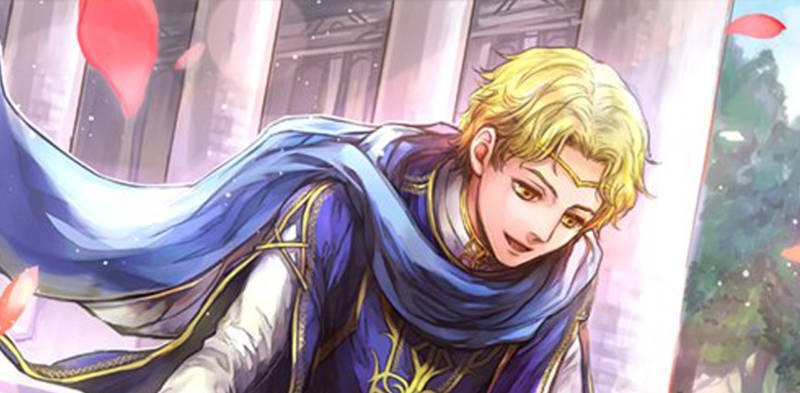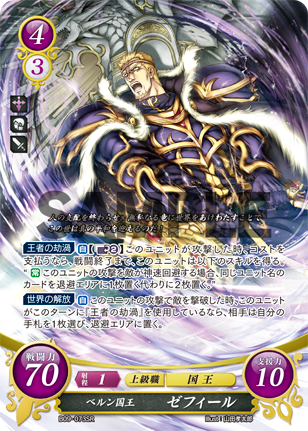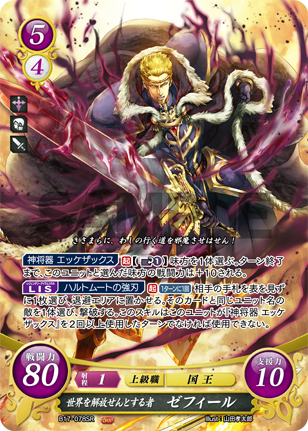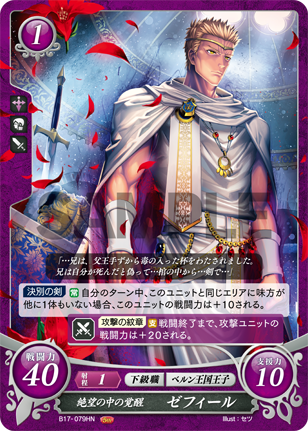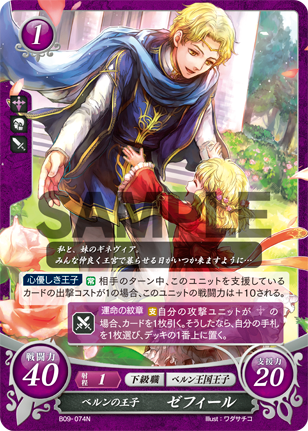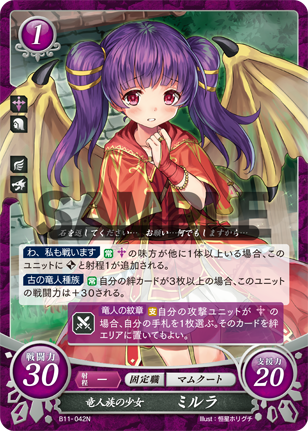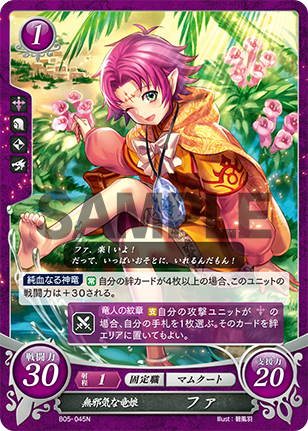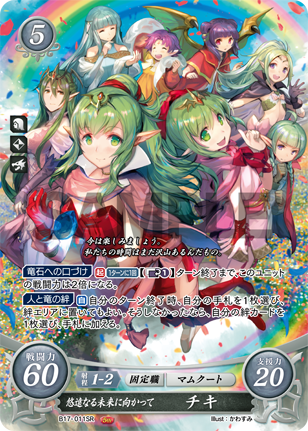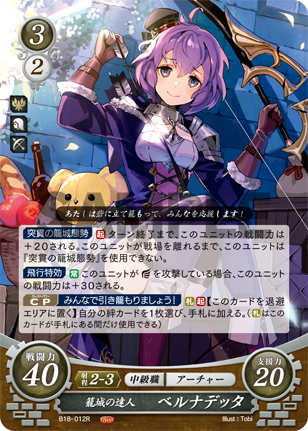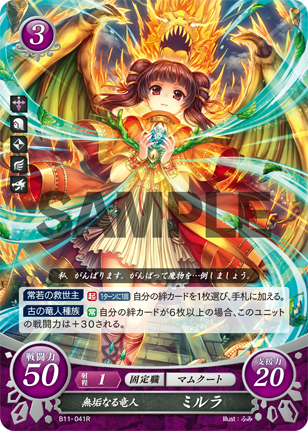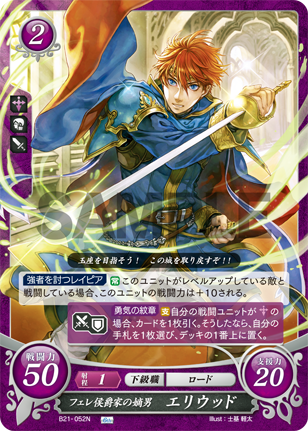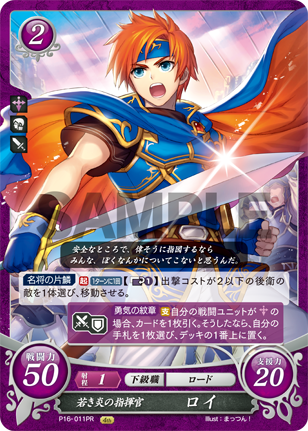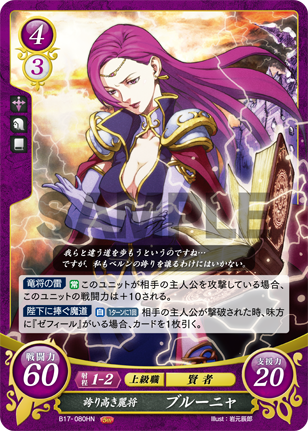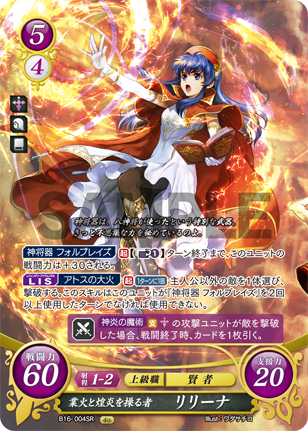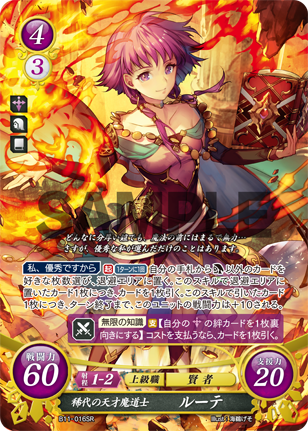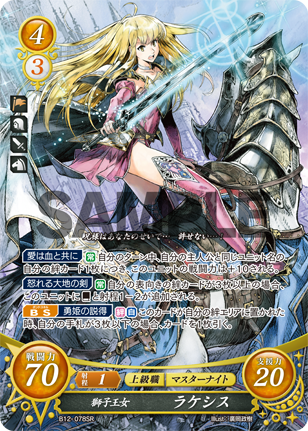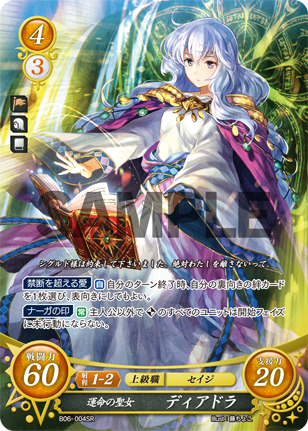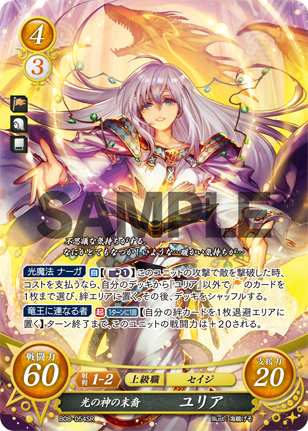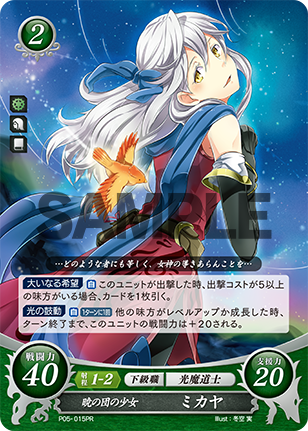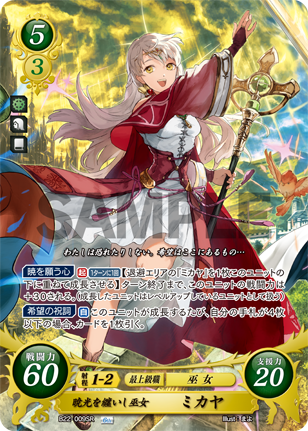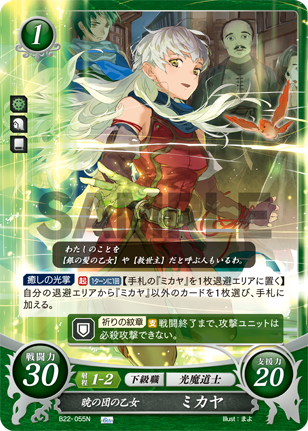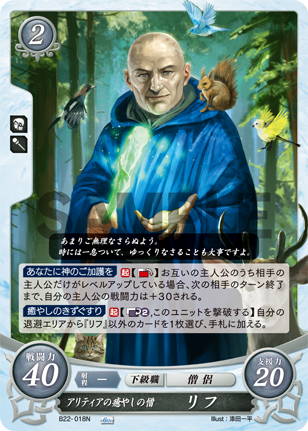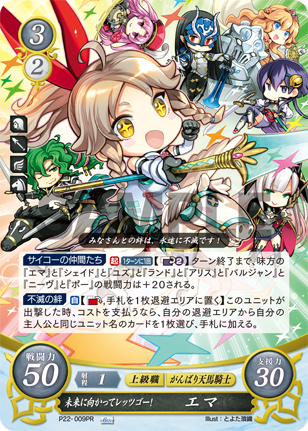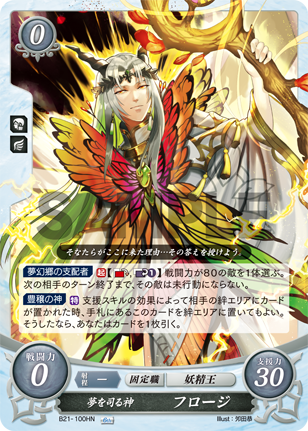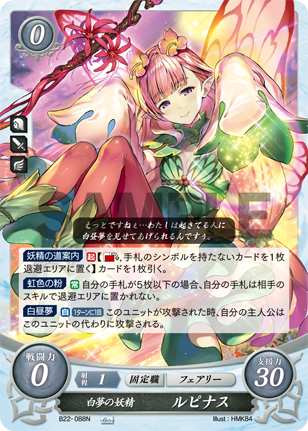Fire Emblem Cipher Primer – Zephiel
Zephiel, the tyrannical king of Bern, and main antagonist of “Fire Emblem: Sealed Sword” was first introduced into Cipher in set 9. He didn’t make much of splash though. He lacked a bridge promotion, and his only available option at the time was a gimmicky 4-cost/3-promote that had the potential to destroy an opponent’s hand, but wasn’t exactly solid enough to close out games.
However, almost 3 years later, he received a new set of support cards in set 17, turning him into the undisputed strongest deck of the format. He’s not quite as hard to topple as he was on release, but Zephiel’s spite for humanity, and the sheer oppressive force he exerts in “Sealed Sword,” is perfectly captured by his Set 17 final promotion. Zephiel is a powerful and unorthodox main character option, but when played properly, is an unbeatable monster.
First, let’s look at his final promotion, it’s a 5-cost/4-promote base 80 with two effects. The first is “Eckesachs,” the mighty blade of the king of Bern. For the cost of one bond, Zephiel can increase his own power and the power of another unit the player controls by 10 until the end of the turn. This effect is not once per-turn, and can be used even if Zephiel is the only unit the player controls.
His second ability is a once per-turn “Legendary Skill,” that requires having used Eckesachs at least twice first: “Hartmut.” Hartmut forces the opponent to discard a card at random, and if that card shares a name with any unit they control, it destroys that unit on the field as well.
Indiscriminate destruction effects are incredibly powerful in Cipher, and Zephiel is one of the few units to have one. Hartmut is one of the primary reasons Zephiel is so strong, as the ability is antithetical to how Cipher is meant to be played. Players often want ways to dodge attacks as their orb counts gets lower over time. Zephiel punishes this by simply forcing the card out of the opponent’s hand and destroying them for it anyways. If your opponent happens to lack any copies of their main character, then Zephiel can simply swing instead. His base-80 body pretty much guarantees he’ll trade even, if not over, the majority of other MC options. The only true downside to Zephiel is that his gimmick is a 2-bond investment, meaning that the timing and uses for Hartmut need to be done properly to ensure Zephiel keeps the momentum to push for game. Even if Zephiel fails to grab a copy of the main character through Hartmut though, simply denying resources by discard is incredibly powerful against a lot of decks, and can set them back even when he fails at his main game plan.
His set 9 that we already touched on, also has two different abilities. The first one triggers when he attacks. By paying 2 bonds, Zephiel forces the opponent to discard 2 copies of their targeted unit to dodge his attack. His second ability is a follow up, that forces the opponent to discard a card from their hand when Zephiel destroys a unit.
Neither of these effects are once per-turn, but the second ability, named “Liberate the World,” only care that the first ability was activated at least once. You could theoretically force your opponent to discard their entire hand this way with the right number of ways to refresh Zephiel, and also assuming your opponent has enough destructible units on the field. A lot of decks tend to skip this promotion. The base 70 power makes it easier for him to be destroyed by an enemy, and the 10-support power he provides mucks up the deck’s combat potential. If one really feels compelled to use this version of the king in their build, they should probably restrict themselves to 1 or 2 copies unless they are focusing exclusively on using it as their final promotion.
Zephiel has no bridge promotion, but he does have two different 1 cost variants. His set 17 is a base 40 with 10 support that gains +10 on the player’s turns as long as he is the only unit the player controls in his line. This specific version of Zephiel doesn’t mix well with his general strategy, so it’s often skipped over, and not even run as a dodge option.
His set 9 on the other hand, might just be one of the best wall units in the game, and should always be run at 4 copies. It’s a base-40 with 20-support and an incredibly strong effect that gives Zephiel an additional +10 power on defense when his support card is a 1-cost unit. This 1-cost requirement does not care about things like color, so it turns any 1-cost 20-support into a 30, and any 30 into a 40. It’s very hard to get over Zephiel early on as he will commonly hit 70 or 80 power on defense, which even most bridge promotion units can struggle with handling. Some early builds of Zephiel specifically ran a lot of 1-cost fliers for this particular reason.
Currently, Zephiel still wants to run a healthy amount of 1-costs, primarily units with Dark Magic supports that force the opponent to discard while they have 5 or more cards in hand, units that get powered up when their support is in a matching color (typically purple), or strong ranged units like archers. Zephiel exists within a weird space, where he wants to guarantee as many successful hits as possible, so varying up what units he has can work out better in the long run than trying to run a bunch of things at 4-ofs. You really want to push as early as possible to make games quicker and close out immediately after he class changes. You opponent should be at or near their last orb by the time Zephiel hits 4 bonds.
In “Sealed Sword,” Zephiel wanted to create a world liberated of humans and ruled by dragons, so it should be no coincidence that his best staples are the two Manakete units, Fa and Myrrh. Surviving to turn 4 is a bit easier for Zephiel than most other decks, but often times simply resolving 1 or 2 dragon supports is enough to give him a bond lead and close out early. The quicker he hits his promotion, the quicker he can close out a game. Four copies of each 1-cost dragon is a requirement.
Zephiel has amazing offensive and defensive power, and having access to two bond-accelerators can speed up his game plan, but he does lack in a few areas. For starters, he can’t really draw or recover cards consistently like other strong decks, so he needs these weaknesses covered in other ways. A lot of Zephiel’s late game needs to be spent stabilizing while either placing new bonds or recycling the ones already on the field. Zephiel isn’t looking to mass-deploy an army, he just wants to make sure he has enough face-up bonds to do the things he needs to win.
Cards like Set 17 Tiki are an absolute godsend for him, since she can either replace a new bond from hand, or add an unused bond back to hand at the end of the player’s turn. Myrrh’s 3-cost variant as well as set 18 Brenadetta can serve similar roles too, and it’s recommended to have 4-5 recycle options just to make sure you’re likely to get one by the time you’ve used most of your bonds up.
Purple has a lot of very strong draw and recovery effects as well. Units like Eliwood and Roy both have variants of “Fate Emblem,” which lets the player draw a card and then put a card from their hand back on top of their deck. This is typically an offensive skill, but these two have variations that can happen on defense as well, giving Zephiel an easy way to dodge potential support fails, set up dragon emblem resource ramps on his turn, or just stack something that will be harder to get over on the opponent’s turn.
Zephiel actually has his own dedicated support mage in Brunnya, who let’s the player draw a card once per-turn when the enemy main character is destroyed, as long as you also control a Zephiel. She also has the added bonus of gaining an additional +10 power whenever she attacks the enemy main character, turning her into a base-70 ranged threat. If your opponent fails to take out Brunnya, she can easily restock your hand in a few turns, and also becomes a very real threat against most MC options thanks to her natural boost.
Other good late-game purple draw options are Lilina, who grants a draw when a purple unit she’s support destroys and enemy, Roy, who can fix the top card of the deck and then give a draw at the end of the turn, and Lute, who let’s the player draw a card when she’s pulled as a support for the price of 1 purple bond. Having a healthy mix of Fate emblem and draw effects can help Zephiel stay in the mid game should he fail to close out.
Typically, Zephiel’s early game should be focused around staying in purple, with his mid/late-game options being a mix of Purple and whatever his secondary option is (should you choose to use one).
Whatever secondary options you considered should cover one, if not both, of his two main weaknesses, lack of draw power, and lack of useable bonds. Yellow is a somewhat solid option for him, since Lachesis is already a staple for him. Hitting multiple dragon emblem supports early will set Zephiel up for his main promotion, but it will also run his hand abysmally low. Lachesis draws a card when played into the bond area if her controller only has a total of 3 or less cards in hand. Seliph is also another solid option, since he can flip a used bond back over when he’s played into the bond area by the effect of a skill. This can be a bit difficult for Zephiel to do since he’ll need to rely on Dragon Emblem supports, but Tiki can also make the effect happen at the end of the player’s turn. Lastly, Dierdre and Julia are excellent splash options for variety reason.
Dierdre’s set 6 has the ability to reflip one bond at the end of the player’s turn, but also stops all non-main character dragonstone units from recovering. This can be really helpful against certain decks, but considering Zephiel will probably be running a lot of dragons himself, it can be a bit of a risky play. Julia grants the ability pull a card directly from the deck and add it to the bond area when she destroys something in combat, letting her setup cards like Seliph or Lachesis very easily. The downside is that your opponent can simply dodge her attack to prevent you from getting the effect.
Green is another highly viable option for Zephiel, or at least just Micaiah. While strong in her own right, Micaiah is an excellent splash choice since her 2-cost variant gives a draw when played while the player controls a 5-cost or higher unit, and, oh hey, Zephiel happens to be one of those. Her set 22 variant can stack a copy of Micaiah from the retreat underneath herself to gain +90 until the end of the turn, and then let’s the player draw a card each time she’s grown as long as the player has 4 or less cards in hand. A lot of the one-cost Micaiah cards also come with miracle emblem, which stops the enemy from using a critical hit in combat. This makes both the 1-cost Zephiel and the 5-cost almost impossible to get over for the majority of the cast if you happen to pull one on defense. Once again, the set 22 variant comes in handy here, since she has a healing effect that requires 0-bonds and only another copy of Micaiah to use.
Finally, I wanted to talk about a heavy colorless variant, or at least a few colorless cards that can go a long way in Zephiel. First is a Wrys, a 2-cost healer with two effects. First, he can exhaust himself to boost your main character by +30 until the end of the opponent’s turn as long as your opponent’s main character has class changed and yours hasn’t. He can also flip 2 bonds and destroy himself to add any non-Wrys card from the retreat to your hand.
Wrys is pretty much wall insurance for the prince, almost guaranteeing your opponent will have to get over a 100-110 wall on their 3rd or 4th turn. The healing effect might seem bad, since it forces you to destroy Wrys, but being able to grab back any unit without a catch means you can grab Zephiel or any support unit you might need in the coming turn like Brunnya, Tiki, or even a bond skill unit like Lachesis. I personally like to run him at 2 or 3, since a lot of other main characters tend to focus on early promoting when possible.
Next up is Ema, She’s a gimmicky healer that can trade a card in your hand for a card in the retreat with the same name as your main character. The only catch is that the effect can only be used when she is deployed. She also has an ability that lets you flip over 2 bonds to boost all of the Cipher original characters you control by +20 until the end of your opponent’s turn, but we’re really just here for the heal. A 0-bond heal that can happen on the turn before Zephiel needs to class change can sometimes be a make it or break it situation. The only downside is that Emma becomes progressively less and less useful as the game goes on after Zephiel has class changed. If you are running Wrys, you only need 1 or 2 copies of Emma, hell, you probably don’t need any if you have another healer unit that can take her place.
And finally, I want to talk about the Elf units introduced in last few sets. A package of Freyr, Mirabilis, and Plumeria. All of these cards are excellent control options if you want a slightly slower deck. Freyr also has the added benefit of being decent in the mirror or against any other purple deck, since most of them will also be running dragon emblem supports as well. Plumeria can stunt a lot of decks that rely on higher cost units to end games by simply existing on the field, and the effort wasted to remove her will often set your opponent back at least a turn, allowing Zephiel some breathing room. Mirabilis is a good mirror tech since she can prevent discard effects from hitting you, but she also acts as a good filter unit if you stock up on colorless options since she can exhaust herself and discard a colorless card to then draw a different card.
Here are some lists based on the splash options I talked about. First is a purple/yellow build that uses Dierdre and Julia to help control and accelerate bonds.
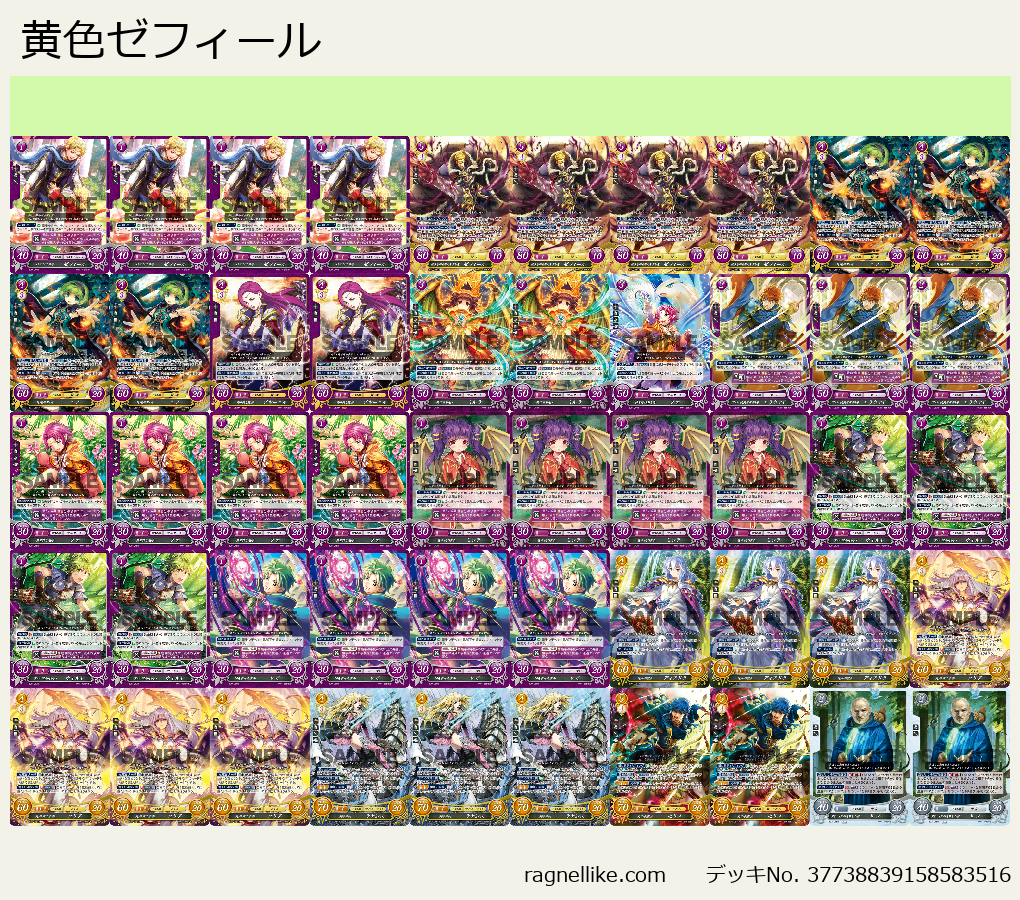
Next is a green build that uses Micaiah,
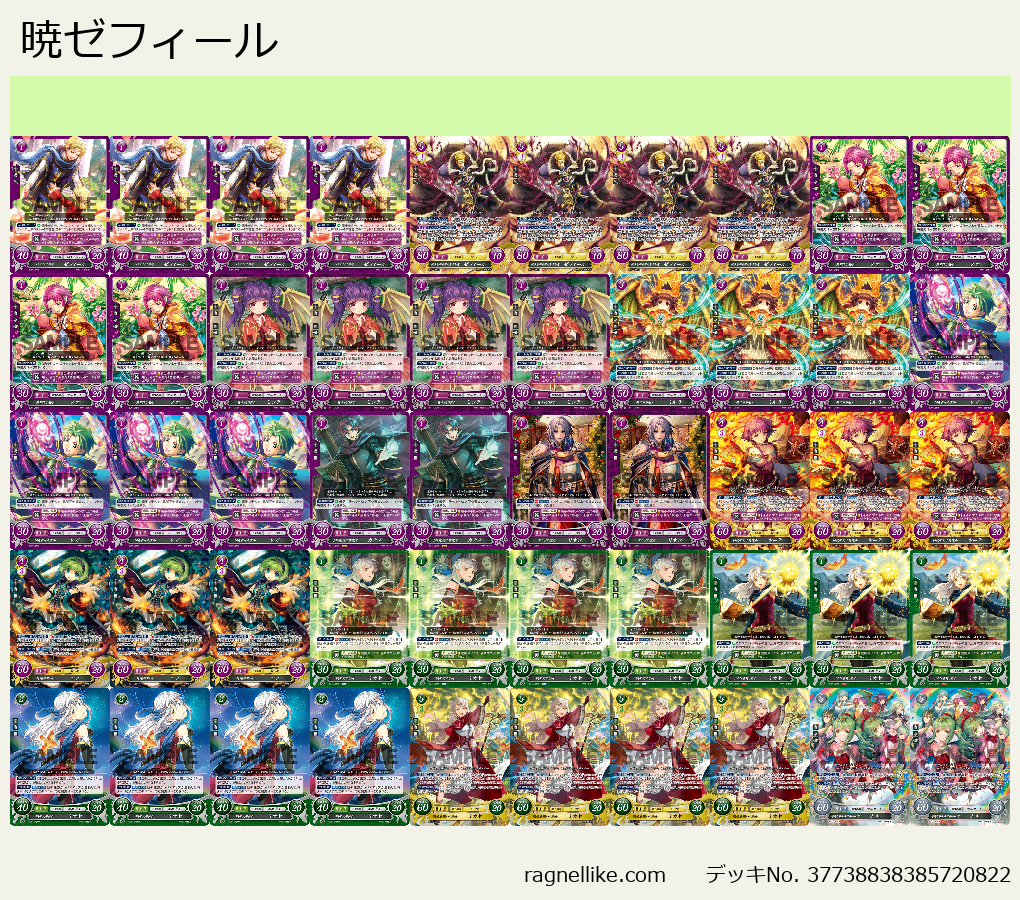
And finally, here’s a rework of a build I used at an arena event back in November 2020 and took 4th with.
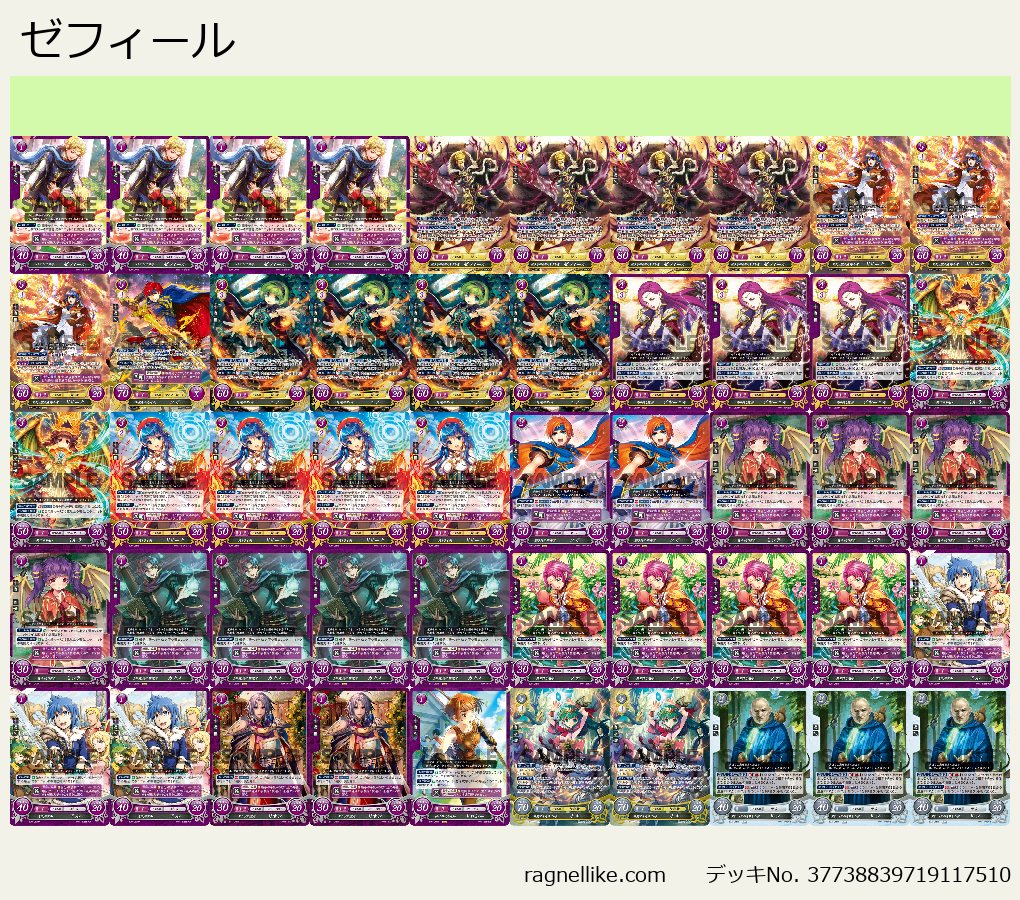
Zephiel is an incredibly oppressive deck. He’s without a doubt, still one of the strongest main characters in the game, even if he lacks a lot of the gimmicks or extensions other characters have. If you just really, REALLY, want to win, you can’t go wrong with Zephiel.
